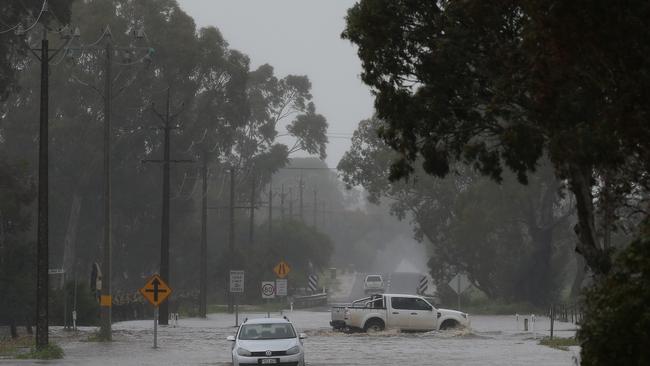Daniel Wills: First AEMO report on SA-wide blackout raises uncomfortable questions about renewables
ANALYSIS: JAY Weatherill has rarely looked so rattled as in today’s response to a report on the statewide blackout that raises uncomfortable questions about SA’s embrace of wind power.
- Report sheds light into SA blackout
- After the storms, SA bracing for food price surge
- $30m in crops wiped out in SA storms
PREMIER Jay Weatherill has rarely looked so rattled as during today’s response to a report on the statewide blackout that raises uncomfortable questions about SA’s embrace of wind power.
It is important to note the Australian Energy Market Operator is not finished with its inquiries.
It reports again in a fortnight’s time and full clarity may be six months away, if we get it at all.
But today’s early findings seriously challenge Mr Weatherill’s blanket declaration last week that what happened at 3.48pm on Wednesday was “a weather event, not a renewable energy event”.
It also poses questions for the whole country about how its energy supply is changing.
There is no dispute that the violent storm, and twin tornadoes that knocked out 23 electricity towers and three high voltage lines, triggered interruption to power supplies in the state’s north.
The outstanding question is why all of the state, and 1.2 million people in Adelaide, lost power.
AEMO explains it this way.
A large amount of wind power was taken offline as the system attempted to right itself. We do not know why, but they often need to stop in extreme weather.
Then, SA attempted to cover that shortfall from wind power that had been pulled by calling on extra supply from Victoria.

That demand was too much for the interconnector to take and it tripped out, leaving SA to fend for itself and rely only on local generators to keep lights on.
Suddenly, the frequency of the system collapsed and the entire state went dark.
We don’t know exactly why, but one of the known problems with wind is its inability to hold stable frequency.
AEMO, says: “Additional analysis is required to determine the reasons for the reduction in generation and observed voltage levels before any conclusions can be drawn”.
Just as it was wrong for anyone, including Mr Weatherill and his conservative political rivals, to make absolute claims last week about blackout’s cause, it remains too early today to do so.
But on the balance of probabilities it seems right to speculate and suspect that the state’s unique mix of energy supply, namely high levels of wind, contributed to a unique engineering disaster.
If that is the case, the state remains exposed to the same thing happening again in the future.
That is an unacceptable danger that must be addressed before any politics are played.
Mr Weatherill seemed in active denial today of the more complete picture now presented by AEMO.
There was no recognition of the independent findings that question the role of wind.
He went immediately to the politics, accusing the Coalition and Senator Nick Xenophon of point scoring in the wake of last Wednesday, In doing so, he committed the same sin he criticised.
While the state just wants to know from its leaders what were the causes and solutions to the blackout, it watched again as the political class continued its own fight inside the bubble.
And then Mr Weatherill reduced the complex and critical issue of energy security to a simple line that: “There’s really a choice. Are you a supporter of coal or ... of renewable energy”.
This is the worst of false choices.
The country is obviously going to have to walk a middle path.
Australia is signed up to an international agreement to keep global warming at below 2C, to prevent more frequent natural disasters and costs in dealing with rising oceans and the like.
It will need to find both commercial and technical solutions for getting there.
This question is one the whole country will have to grapple with, as it tries to deliver both a social benefit in reduced emissions and avoid economic costs of high prices and dodgy supply.
If wind is shown to be a poor technology, because it can’t provide reliable and affordable prices across the network, attention will need to move to things like baseload solar and batteries.
Simply telling people to pick wind or coal gets us further away from a real solution.
It is possible to both accept the science of climate change and doubt the merit of our responses.
Denialism is also found on both ends of the political spectrum, and is on wide display today.
The local politics of the blackout will be as complex as the energy market that led to it.
For many people, their conclusions about what caused the blackout is formed far more by how they vote than what can be factually observed.
They crave a simple all-or-nothing call.
Having made his grand declaration last week, Mr Weatherill has now just doubled down.
Ignoring today’s uncomfortable facts is also less embarrassing than admitting last week’s mistake and he seems to be banking that a general level of support for renewables in SA to carry him through a political debate where multiple and complex factors have contributed to a blackout.
And the bulk of voters who will swing the next election live in Adelaide, where power came back on relatively quickly, chaos was minimal and support for climate change action higher.
But that won’t hold if further updates from the regulator firm doubts about the role of wind.
That will be especially so if the viability of the Whyalla steelworks is negatively impacted or big regional businesses like BHP Billiton and Nyrstar rethink the scale of their operations.
There are odd echoes today from the Child Protection Systems Royal Commission, where the Mr Weatherill denied for an extended time that there was a problem.
He continued to do so until the last moment when a credible an independent voice screamed the facts didn’t match rhetoric.
And if it is proven beyond doubt that past SA policies of wind farm promotion made the blackout more serious, there will be a double blow to Mr Weatherill’s credibility.
Not only will he and the Government then be held directly accountable for huge economic costs and social danger, but seen to have misled the public about it for sheer political interest.



